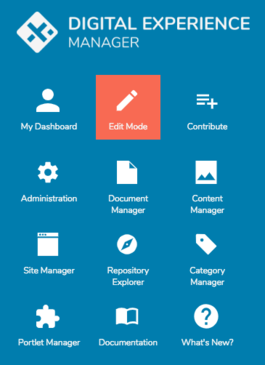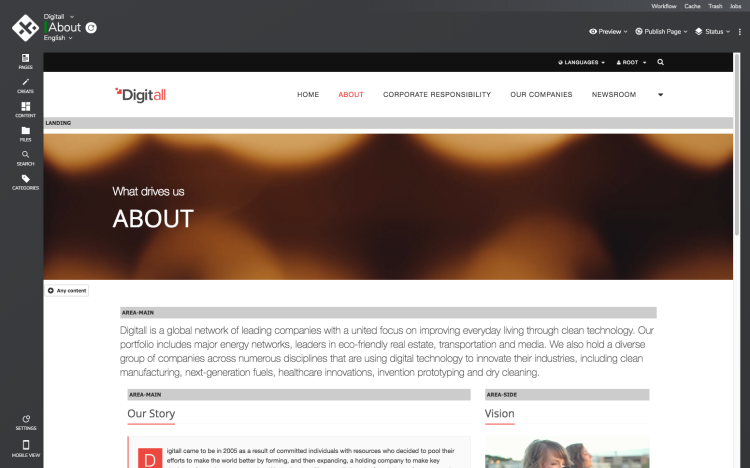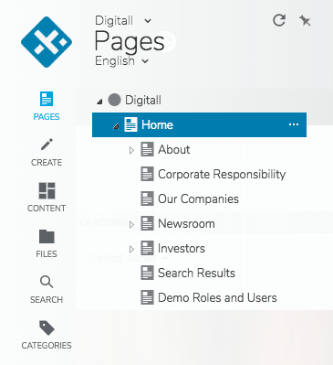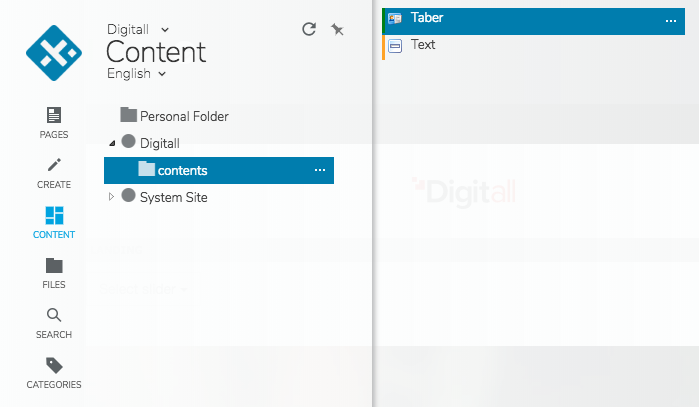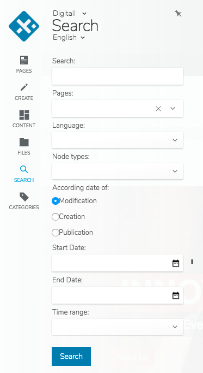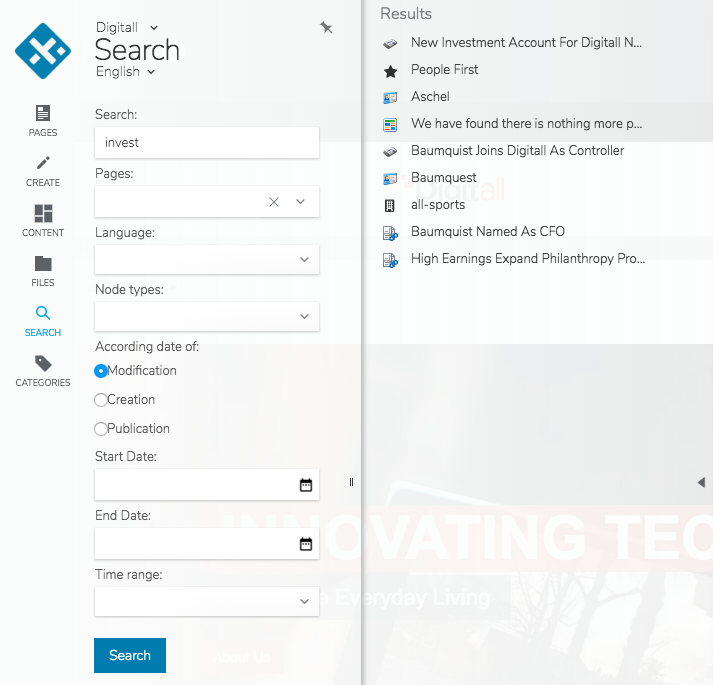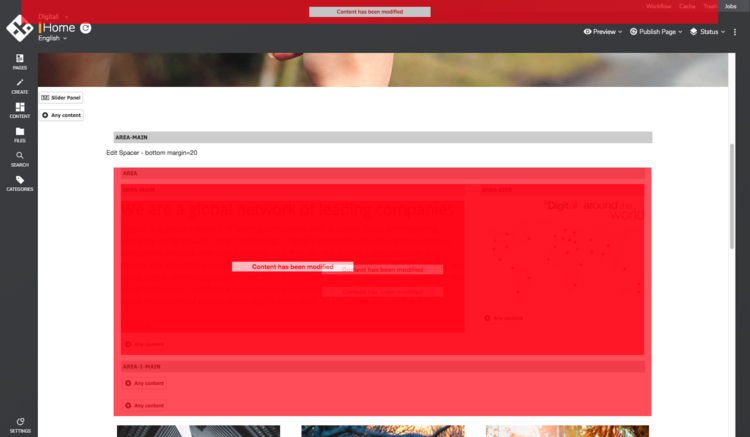Working in Edit mode
1 Access
The edit mode can be accessed from the DX Menu:
2 Presentation
The Edit Mode is the most advanced mode available in Digital Experience Manager to edit contents in the context of a site. The site, displayed in the edit frame, is the one coming from the workspace, it is not the site as it appears online. You can browse the site just like you would do in its live version. The pages contains areas and lists which contain the contents. Please consult "How to contribute content" documentation.
The edit frame is bordered by 3 toolbars:
- The left toolbar contains the features to manage the site map (and to quickly jump to a page), to create and find contents
- The page/selection toolbar displays the current page or selected item with the corresponding edit menu, the preview menu, publication, status, the language and site switchers, as well as the DX Menu button
- The application toolbar provides access to workflow, cache, trash and application jobs tools
3 Left toolbar
The left toolbar allows to:
- Browse the pages of the site and update the sitemap
- List the types of contents that can be created on the site
- Browse the out-of-context contents, so they can be added to the current page
- Browse the files and images, so they can be added to the current page
- Search for contents, and have the possibility to add them in the current page
- List the contents associated to a category, and have the possibility to add them in the current page
Clicking on of this button will display the corresponding tab, in the “left panel”:
By default, the tab is displayed over the page. It becomes hidden when:
- The user clicks again on the same left toolbar button
- The user clicks anywhere in the page in the edit frame
- The user starts to drag-and-drop a content
In order to keep this left panel open, you can click on the pin button . The edit frame is then re-centered and the pin button turns blue. Clicking again on it brings you back to the default behavior.
The button is used to manually refresh the left panel. By default the left panel is automatically refreshed when
- a page is added in the tree
- a workflow is started or move forward
- a publication is finished
- the language is changed
It is possible that your administrator has disabled this automatic refresh (as it can be inconvenient when lots of publications happen at the same time). In such case, the refresh icon turns blue, indicating that a manual refresh is needed.
3.1 Pages
At the top of this tab, users can find a site switcher, allowing them to quickly switch from one site to another, if they are editors on several sites.
The Pages tab displays the sitemap, in other words the page tree of your site. You can directly access a page by clicking on it, so the page will be displayed in the edit area.
You can also manage the site tree, by creating new pages, separators and links directly from this site tree. Please consult the “Pages and navigation contents” documentation.
To edit a page, open its edit engine by selecting the “Edit” option in the contextual menu, which can be opened by either right-clicking on a page or clicking on the “...” button which appears when hovering on the page in the tree.
Pages can be reordered or moved, either by:
- Drag-and-drop
- Cut and paste
Two options exist when pasting a copied page:
- “Paste”: this will copy the page and its subpages. All the contents are duplicated, meaning that they are now independent from the source page, and can be modified without impacting the source ones
- “Paste one page”: this copies only the page, and not the subpages
The first element displayed in the page tree is the site itself, and can be distinguished with its circle icon. Site level permissions should be set from the edit engine of the site, which can be opened the same way as any page.
3.2 Create
This tab gives access to the components (content types and features) available on your site when create new contents in your pages. Components can be drag and dropped in the Edit Frame to create a new content of the selected type.
Components are organized into logical groups. The different component groups can be opened or closed with the little arrows that precede their names, displaying elements that make them up, and that can be inserted into the pages.
An input field above the component list can be used to quickly filter components as text is entered. When you know the name of the component you are looking for, it is faster to filter the list to make it appear, rather than browsing it by opening and closing component category nodes. The entry in the filter field does not need to be validated, as it operates in real time as text is entered.
More info on content creation is available here.
3.3 Content (out-of-context contents)
This tab is used to browse the folders containing out-of-context contents. Such contents are found in the “contents” folder of every site, as well as in the personal folder of the user.
The elements inside a content folder are displayed when the folder is selected. The color indicator next to every element corresponds to its publication status (in other words if the content has been published, has been modified, etc.).
These elements can be dragged and dropped in the desired location of the current page in order to create a reference.
You can create new folders and upload files through the contextual menu of the folders.
Note that the “contents” folder of “System Site” is mainly used to share contents between sites. This case might not apply for you.
3.4 Files (and images)
This tab is used to browse folders containing files and images. The files are stored in the “contents” folder of every site, as well as in the personal folder of the user.
These files and images can be dragged and dropped in the desired location of the current page in order to create a reference.
By right-clicking on a file or image, you open the contextual menu, from which you can:
- Download the file or image
- Display a preview of the image
You can create new folders and upload files through the contextual menu of the folders.
Note that the “contents” folder of “System Site” is mainly used to share contents between sites. This case might not apply for you.
3.5 Search
This tab handles full-text searches of any type of content, including all binaries you can browse with the File manager. Several options are available to simplify search and make it faster:
- The standard operators AND, OR, NOT
- Quotes to search for a specific phrase ( "content manager")
- The wildcard character * is allowed (Flo* -> Florence, Flower, etc)
To speed up your searches, you can make them more specific and restrict them:
- To part of the tree by specifying the departure point of the search (Page picker)
- To a language by selecting from the available languages in a drop-down menu
- To a specific editorial content type by selecting from the various types from a drop-down menu
You can also refine the search scope by choosing a date range (start date – end date) or a duration (in months). Those dates or duration will be compared to the chosen metadata: creation date, modification date or publication date.
Content items listed in the search results can be selected, and inserted into the current page with a simple drag and drop. The original content is neither moved, nor modified. This action simply creates a reference to the content.
When opening the contextual menu on a search result item, the option "Go to content" appears. This redirects to the page containing the content or the content itself, if it can be displayed on its own. The option "Go to content" is not available for out-of-context contents, i.e. contents created in the "contents" folder of the site. Note: in the "Usages" tab of out-of-context contents, you can find links to all the pages or other contents referencing them.
3.6 Categories
Categories are used to classify and enrich contents. Categories are organised in a tree, meaning that a category can have sub-categories. The “Categories” tab allows you to browse this category tree and to display the contents associated to the selected category:
These elements can be dragged and dropped in the desired location of the current page in order to create a reference.
3.7 Mobile View
This button allows authors to display the site in the edit frame as it would appear on a mobile device. 4 mobile devices are available:
- Phone: iPhone
- Phone:Android
- Tablet: iPad
- Tablet: Android
Editors can continue to work on the content exactly as if no channel selection is applied.
It’s also possible to change the device orientation using the button.
The "Autofit" button adjusts the size of the device to your screen. It is particularly useful when selecting a tablet.
It is possible to define if a content should be displayed or not on selected mobile device types (“Channels”). This is done using the “Channels” tab in the edit engine of the content.
3.8 Site Settings
This tab is visible only by users with special permissions to manage global site settings and access specific site features. The site administration topic is covered in this documentation.
4 Page/Selection toolbar
In the center of the Page/Selection toolbar is displayed the name of the page currently displayed. If one content in the page is selected (by clicking on a content), then its name is displayed below the page name:
If several contents are selected in the page, then the number of selected items is displayed below the page name:
To clear the selection, either click on the button or click anywhere on the page.
4.1 DX Menu button
This menu allows switching from one mode to another by accessing to the general menu. The items listed depend on the user rights.
4.2 Site selector
If the user is an editor on several sites, he can use the site selector to switch from one site to another. The home page of the selected site will then be displayed in the edit frame.
4.3 Language switcher
If the site is available in several language, the language switcher allows you to display the current page in any available language for the site.
4.4 Preview menu
The preview button opens, in a new tab, the page in its staging version. More options are available when clicking on the preview drop down button:
- Live: shows the site in its live version
- Preview: shows the site in its workspace version
- Customized preview: this allows you to preview the site for a selected user (in case of specific live roles are set on contents) at a given date (in case of visibility conditions are set on contents). You can also chose to preview the site as it would look on a mobile device.
- Compare staging to live version: displays the page or selected content as it is online side to side with the workspace version of it, and allowing you to highlight the differences
- Compare 2 published versions: this allows you to compare a page, or selected content, as it appeared at two different dates.
- Show published versions: displays the version of a content as it was at a selected date
Please note that previous versions of contents might not be available as they can be deleted for server administration purposes.
4.5 Publication
The publication button opens the publication dashboard either for the current page or the currently selected item(s), in the current language. More options are available when clicking on the publication drop down button:
- Publish the page / selected item(s) in the current language
- Publish the page / selected item(s) in all the languages of the site
- Unpublish the page / selected item(s) in the current language
Finally
- Open the Publication Manager, a tool to manually select multiple items and launch a publication process
The documentation regarding publication is available here.
4.6 Status
4.6.1 Publication status
It is possible to see the publication status (published, never published, unpublished, modified) of all the contents of a page by checking the box "Show Publication status" in the “Status” menu. Information layers are then displayed on the page. To mask these layers, you can either click on one of them, or uncheck the box in the “Status” menu.
4.6.2 Permission status
The permission status shows a little icon over contents on which roles (live and edit) are different compared to the parent content:
4.6.3 Visbility status
The visibility status shows a little icon over contents subjected to visibility conditions. A red icon indicates that the content is currently not visible online (the visibility conditions are not met), a green one indicates that the content is currently visible online (the visibility conditions are met).
4.6.4 Show untranslated contents
This option is only displayed for multilingual sites. It allows you to see in the page if content items have been created in other languages in the current page, and which miss a translation in the current language.
4.7 Option Menu
This option menu corresponds to the contextual menu of the current page or the currently selected content(s). The options displayed depends on the selected content(s) and the roles of the user. The most common menu options are:
- Edit: open the edit engine of the content
- Delete
- Copy
- Translate: open the content translation interface, for sites available in several languages
- Export
- Import
- Lock
5 Application toolbar
5.1 Workflow
This menu allows to:
- Execute tasks at particular steps of an ongoing workflow in which the user is involved. The documentation regarding the workflow dashboard is available here.
- Start different workflows (depending on/if specific workflow processes are deployed on your platform)
The number of workflow tasks awaiting an action is displayed over the Workflow menu: 
5.2 Trash
This button gives access to the list of content items “marked for deletion” meaning that their deletion has been required by an author but is not definitively done. Contents can be undeleted from the trash, or, on the contrary, permanently deleted.
5.3 Cache
This menu is only avaibale to certain administrators. It gives the possibility to manually flush caches in Live Mode.
- For the selected object in the Edit-Frame (or the page currently displayed if no item is selected)
- For the full site (this may have a deep impact on performances)
- For the whole platform (this may have a very deep impact on performances)
5.4 Jobs
This button is available for users allowed to open the background job management window. When a publication job is happening, the job button looks like: 
